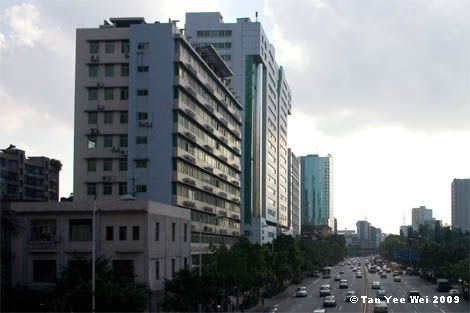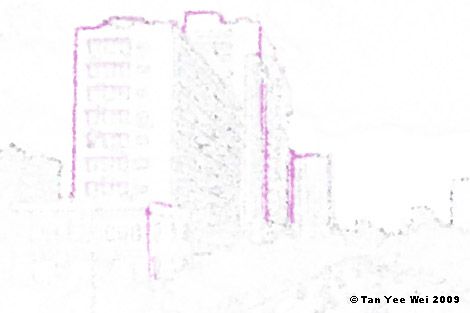When the visual cortex stops working
Today, I watched my brain turn itself inside-out. A thoroughly frightful experience, but very “interesting” (but only in the way a scientist would use the expression).

I had just disembarked from the overnight sleeper train from Tianjin, and was making my way out of the Shanghai train station towards the metro station. All of a sudden, I felt faint. After I climbed a flight of stairs up to ground level, it felt much worse. I was wobbly, and had to stop walking to hold on to a wall to prevent myself from falling over. My vision blacked out completely- I could see nothing. This lasted for about 10 seconds.
My sense of balance was failing rapidly, and even the wall was not helping me keep upright. I had to squat down and brace my head in by hands. All this while, I was worried my condition would deteriorate further causing me to keel over and pass out on the wet pavement in the rain (and lose my computer, passport and phones). This lasted for approximately 10 seconds until my sense of balance and vision returned, just barely.
I became aware of a motorcycle-taxi behind me asking if I needed a ride. I told him my address, he quoted me 15 yuan. It was a slaughter (a normal taxi would have cost 11 yuan), but I was in no shape to haggle.
I was able to get on the bike and keep myself in balance without problem, but my vision was still bedlam. In hind sight, this is not very surprising as the visual cortex is of substantial size, and visual processing is a very resource intensive task.
Below is a Photoshop recreation of my rather useless sense of vision at that time.

Normal view
Click here for large size image

WTF view
Click here for large size image
Allow me to attempt to describe what little I could see.
It was an overcast day with light drizzle, so the sky was entirely white. My field of vision had returned to normal, however, everything was in very very low resolution. In the middle of my field of vision, I could ‘see’ some detail, but everything else was a blur of white and splotches of dull colours.
When I look at buildings, I see it as if it was a pencil sketch on white paper. I could perceive some of the edges of buildings- these edges were rendered in a plain purplish colour. The rest was mostly white in colour. It appears that the perceived edges were moving with respect to my field of vision. This is consistent with findings that moving objects are easier to detect compared to stationary ones 1. Conceivably, the perception of moving objects is given a higher priority in the visual processing part of the brain.
Over the course of 5 minutes, I regained my sense of vision. I could walk and keep balance as if nothing had happened.
Footnotes:
1 – This is important for the survival of many species. A moving object could well be a predator, and being able to detect a predator early would increase the creature’s chances of not being eaten.

I had just disembarked from the overnight sleeper train from Tianjin, and was making my way out of the Shanghai train station towards the metro station. All of a sudden, I felt faint. After I climbed a flight of stairs up to ground level, it felt much worse. I was wobbly, and had to stop walking to hold on to a wall to prevent myself from falling over. My vision blacked out completely- I could see nothing. This lasted for about 10 seconds.
My sense of balance was failing rapidly, and even the wall was not helping me keep upright. I had to squat down and brace my head in by hands. All this while, I was worried my condition would deteriorate further causing me to keel over and pass out on the wet pavement in the rain (and lose my computer, passport and phones). This lasted for approximately 10 seconds until my sense of balance and vision returned, just barely.
I became aware of a motorcycle-taxi behind me asking if I needed a ride. I told him my address, he quoted me 15 yuan. It was a slaughter (a normal taxi would have cost 11 yuan), but I was in no shape to haggle.
I was able to get on the bike and keep myself in balance without problem, but my vision was still bedlam. In hind sight, this is not very surprising as the visual cortex is of substantial size, and visual processing is a very resource intensive task.
Below is a Photoshop recreation of my rather useless sense of vision at that time.

Normal view
Click here for large size image

WTF view
Click here for large size image
Allow me to attempt to describe what little I could see.
It was an overcast day with light drizzle, so the sky was entirely white. My field of vision had returned to normal, however, everything was in very very low resolution. In the middle of my field of vision, I could ‘see’ some detail, but everything else was a blur of white and splotches of dull colours.
When I look at buildings, I see it as if it was a pencil sketch on white paper. I could perceive some of the edges of buildings- these edges were rendered in a plain purplish colour. The rest was mostly white in colour. It appears that the perceived edges were moving with respect to my field of vision. This is consistent with findings that moving objects are easier to detect compared to stationary ones 1. Conceivably, the perception of moving objects is given a higher priority in the visual processing part of the brain.
Over the course of 5 minutes, I regained my sense of vision. I could walk and keep balance as if nothing had happened.
Footnotes:
1 – This is important for the survival of many species. A moving object could well be a predator, and being able to detect a predator early would increase the creature’s chances of not being eaten.
Labels: natural science, observations, personal

<< Home